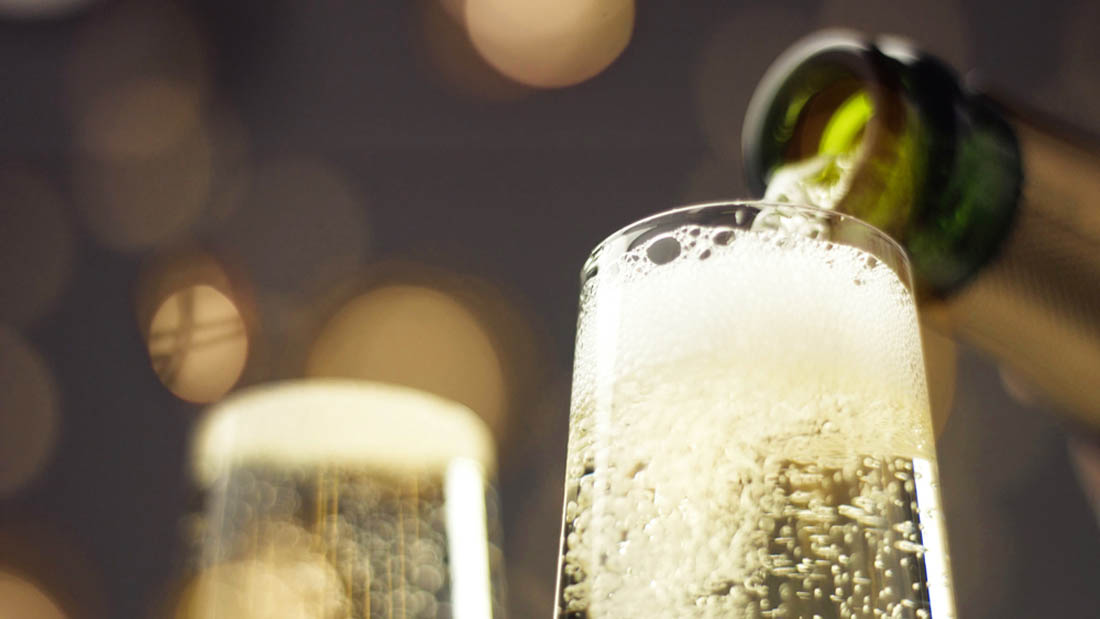
15 Jan What is Sparkling Wine and How is It Made?
Sparkling wines are the ones with bubbles and is the reason why they sparkle. This incredibly unique wine has high levels of carbon dioxide, which makes it fizzy. It is arguably one of the most technical wines, as it doesn’t undergo only one fermentation, but two.
How Is Sparkling Wine Made?
A large majority of sparkling wines often go through two fermentations. One of them is to turn the grapes into wine without the bubbles, referred to as a base wine. While the second fermentation turns the base wine into a fizzy one. Winemakers add yeast and sugars to the base wine in the latter process. The addition of yeast slowly converts the sugar into CO2 bubbles and alcohol, lending it fizz.
Carbon dioxide is a natural by-product of yeast converting sugar into alcohol. The fermentation that takes place in a sealed container prevents carbon dioxide from escaping. The CO2 then is trapped in the wine in bubble form.
The slower and more prolonged the winemaking process, the more expensive and complicated the sparkling wine. While most sparkling wines take roughly 10 years to make, some can also be produced within months. Wines that take years to complete can cost as much as $100 a bottle, while the others go for around $4 a bottle.
Types of Sparkling Wine Fermentation
Tank Fermentation
This is one of the most efficient ways of making sparkling wine. It involves carrying out the second round of fermentation in a large pressurized tank. The tank method could also be called the bulk method or the Charmat method.
Wines that are made using this method are generally the least expensive. This is primarily because they are made in large quantities, and are available right after harvest. The entire process can be completed within a few weeks. Besides, the grapes used for sparkling wines in this method are relatively less expensive than Chardonnay or Pinot Noir that are used in traditional ones.
Bottle Fermentation
In the conventional method of making sparkling wines, the second round of fermentation is carried out in the individual bottles that they’re sold in. The technique is referred to as the classic method in Europe, while it’s called the champagne method in the United States.
Champagne has been made this way for over 300 years and based on the regulations set by the French, it can be made no other way. While sparkling French wines made outside the Champagne region can use the same process, they have to use the term “cremant” rather than champagne. In this elaborate process, each individual bottle becomes a fermentation tank. This process takes roughly about 15 months, including the aging time in the bottle before it’s finally sold, and typically takes about 3 years. Sparkling wines fermented using the bottle method are more expensive than those made via the tank fermentation process.
The Impact of Fermentation Processes on Taste
The two processes used for producing sparkling wine result in two very different tasting wines:
The sparklers in tank-fermented wines are generally fruitier than traditional sparkling wines. This is because, during tank fermentation, the route from the grape to the wine is much shorter than bottle fermentation. Most winemakers use this process because they want their sparklings to be fresh and fruity. Asti, which is Italy’s famous sparkling wine, is the perfect example of this method. However, it’s important to note that Charmat-method wines should be consumed when they’re young. This is because the fruitiness is at its peak when they’re young.
On the other hand, bottle-fermented wines are relatively less fruity than tank-fermented ones. This is because the chemical reactions that take place while the wine develops slowly diminish its fruitiness. However, it does contribute to flavours like caramel, toastiness, yeastiness, and nuttiness. The texture of the wine also changes to a more creamy and smooth finish. While the bubbles are tinier, they are less aggressive than tank-fermented wines
To find out how Signature Cellars can help you design and build a wine storage solution that can help protect your investment and add value to your home, call us on 1300 570 636 or email info@signaturecellars.com.au, and we will respond shortly. You can discuss your specific requirements with our team that will provide their inputs and provide superb solutions.
Thanks for reading,
Neil Smallman
Signature Cellars
1300 570 636




No Comments